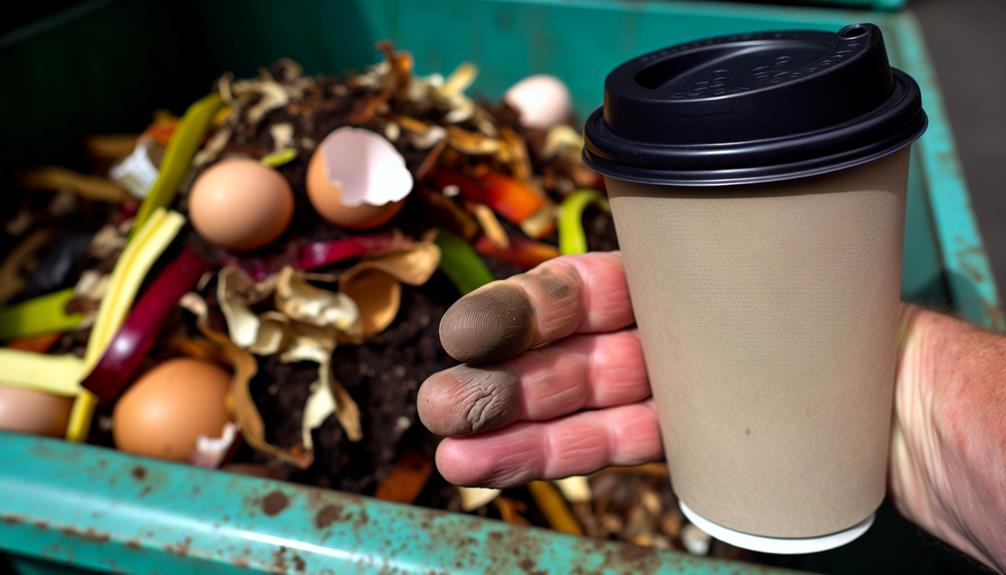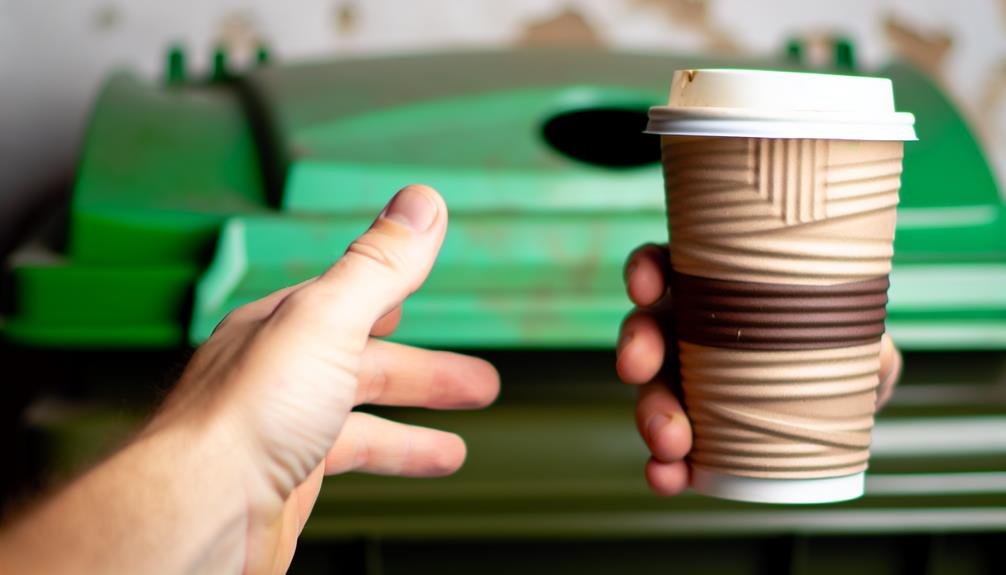

Yes, you can compost coffee cups, but it depends on the materials. Regular paper cups have a plastic lining, making them tough to compost. Look for cups labeled as compostable or certified by the Biodegradable Products Institute (BPI). These usually have plant-based linings like PLA.
To compost such cups, shred them and mix with other organic matter to maintain a balanced carbon-to-nitrogen ratio. Regularly turn your compost pile and keep it as damp as a wrung-out sponge. If you follow these steps, you’ll better manage your compost and reduce waste effectively. There’s more to explore about optimizing composting techniques.
When you’re trying to compost coffee cups, the first thing you need to understand is the different materials they’re made of. Most coffee cups look similar, but their material composition varies greatly. Some are made of paper lined with plastic, while others use biodegradable or compostable materials. Knowing the difference is essential for successful composting.
Standard paper cups often have a thin polyethylene lining to prevent leaks. This plastic layer complicates composting since it doesn’t break down easily. These cups have a notable environmental impact, contributing to landfill waste.
On the other hand, cups labeled as ‘compostable’ usually consist of plant-based materials like PLA (polylactic acid), which decompose more easily under the right conditions.
To make an informed decision, check the cup’s label or packaging. Look for certifications like the Biodegradable Products Institute (BPI) logo, which indicates the cup meets compostability standards.
To effectively compost coffee cups, you’ll need to follow a clear and structured process. Start by shredding the cups into smaller pieces. This increases the surface area and speeds up the decomposition duration.
Next, mix these shredded pieces with other organic matter like vegetable scraps, grass clippings, and leaves. This blend guarantees a balanced carbon-to-nitrogen ratio, essential for efficient composting.
Turn your compost pile regularly to aerate it. Oxygen is vital for the microorganisms breaking down the organic matter. Without it, the process will slow, and your compost could develop unpleasant odors. Aim to turn the pile at least once a week.
Monitor the moisture level. Your compost should be as damp as a wrung-out sponge. If it’s too dry, the decomposition will halt. If it’s too wet, it could become anaerobic, leading to a prolonged decomposition duration.
Temperature is another key factor. A well-maintained compost pile should heat up to between 130-160 degrees Fahrenheit. This heat kills off any potential pathogens and speeds up the breakdown of organic matter.
Also Read: Can You Compost Blood?
Composting coffee cups presents several challenges that can complicate the process. One major issue is the recycling barriers posed by the materials used in most coffee cups.
Typically, these cups are lined with a thin plastic coating to prevent leaks, which doesn’t break down easily in composting systems. This plastic layer creates a significant obstacle because it doesn’t decompose like the paper part of the cup.

Moreover, the material breakdown of these cups takes longer than you might expect. Even in ideal composting conditions, the plastic lining can take years to degrade. This delay can hinder the efficiency of your compost, making it less suitable for quickly producing rich soil for your garden.
Additionally, many composting facilities aren’t equipped to handle these types of materials effectively. They may have restrictions on accepting coffee cups due to the difficulty in processing them. This can leave you feeling stuck, unsure of how to dispose of your used cups responsibly.
Understanding these challenges is essential for anyone wanting to compost coffee cups. By recognizing the recycling barriers and issues with material breakdown, you can better navigate the complexities and make more informed decisions about your composting practices.
Addressing these challenges begins with identifying which coffee cups are truly compostable. First, look for labels or symbols indicating compostability. Many compostable cups are marked with phrases like ‘compostable’ or ‘certified compostable,’ often accompanied by logos from certification bodies such as the Biodegradable Products Institute (BPI). Pay attention to these markings as they help you distinguish between compostable and non-compostable products.
Next, check the material composition. Compostable coffee cups are typically made from plant-based materials like PLA (polylactic acid) or other biodegradable substances. These materials break down more easily in a composting environment compared to conventional plastic-lined cups. Understanding the materials used in your coffee cup is essential for making sustainable packaging choices.
Additionally, recycling symbols can offer valuable information. While recycling symbols primarily guide recycling efforts, they can also help you identify if a cup is made from compostable materials. Look for specific symbols related to composting to make sure you’re making an eco-friendly choice.
Also Read: Can You Compost Celery?
Many eco-friendly alternatives to traditional coffee cups are available, offering sustainable options for your daily caffeine fix. By choosing these alternatives, you’ll enjoy the composting benefits and contribute to a healthier planet.

Here are some sustainable options you can consider:
Also Read: Can You Compost Cat Manure?
To reduce waste, start by choosing reusable alternatives like travel mugs for your coffee.
Implementing home composting can also make a significant impact.
Opt for reusable coffee cups to greatly reduce waste and minimize your environmental footprint. Single-use coffee cups contribute a large amount to environmental pollution and waste. By choosing reusable alternatives, you can make a positive impact on the planet and join a community of environmentally conscious individuals.
Here are three tips to help you make the change:
Implementing home composting can greatly reduce your household waste while enriching your garden soil. Start by setting up compost bins in your backyard or even in a small corner of your kitchen if space is limited. Compost bins come in various sizes and styles, so choose one that fits your needs and space.
Begin by collecting kitchen scraps such as vegetable peels, coffee grounds, and eggshells. These items are rich in nutrients and break down easily. Remember to avoid adding meat, dairy, or oily foods, as they can attract pests and create unpleasant odors. Layer your kitchen scraps with brown materials like dried leaves, cardboard, and newspaper to balance the nitrogen and carbon in your compost.
Turn the compost regularly to aerate it, which speeds up the decomposition process. Moisture is also essential; your compost should be as damp as a wrung-out sponge. If it’s too dry, add some water; if it’s too wet, add more brown materials.
If you compost a non-compostable coffee cup, it won’t break down properly. This leads to negative environmental impact and complicates waste management. It’s important to use compostable items to contribute positively to our planet.
You can’t compost most coffee cup lids and sleeves because their material types often include plastic or treated paper. Their decomposition rate is too slow for typical composting, making them unsuitable for your compost bin.
When composting coffee cups, you might face health risks like chemical leaching from plastic linings and bacterial growth. Stick to compostable cups to keep your compost safe and foster a healthier environment for everyone.
In commercial composting, compostable coffee cups usually take about 3-6 months to break down. The decomposition process is faster in these facilities due to optimized conditions, making you part of an eco-friendly community.
Yes, you can use compostable coffee cups in your home compost bin. Just be patient with the decomposition process; it might take a bit longer than food scraps, but it’s worth it for the environment.
To effectively compost coffee cups, you need to identify those made from compostable materials, such as certain bioplastics or paper with a compostable lining. Be aware that many cups aren’t compostable due to plastic linings.
Look for certified compostable labels, and consider eco-friendly alternatives like reusable cups. Reduce waste by bringing your own cup and encouraging others to do the same.
These steps help guarantee that your efforts in composting are both practical and environmentally beneficial.
